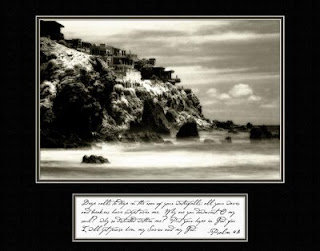I've complained before that the Psalms seem more coherent and more significant in sound-bite form that they are in their totality. It is significant, I think, that we almost never hear a Psalm in its entirety. Readings at public events or worship services tend to pick out three or for consecutive verses that are relatively unified in content, so we are rarely confronted with the radical subject changes, mood shifts, and/or allusions to malicious enemies that likely lie before and after.
Another place you are likely to run into Psalms is in religious inspirational images. These are a commonplace; now that you are thinking about them you will likely start noticing them taped to your coworkers' monitors, in little frames in your relatives' homes, in the waiting rooms of businesses owned by religious entrepreneurs, and so on. Or, if you are a churchgoer, you can probably count a half-dozen of 'em between the foyer and the pastor's office. They're ubiquitous.
The inherent problem with using Psalms in religious art is, I think, quite similar to the inherent problem with television news programs. The problem with television news programs is that important things that affect people's lives (policy, laws, diplomatic efforts, economics, social trends, technological change, scientific development) aren't very photogenic, and things that are exciting to watch (police chases, fires, crowds, weather, baby ducks) aren't really important. The very nature of the medium pretty much guarantees that television news will be trivial, as is in fact the case.
In the case of Psalms, what happens is that passages that can be matched with attractive photography get immediate preference in the inspiration business. Let's take a look at the first three verses of Psalm 42.
We have three verses here that, read together, are a lament of the perceived absence of God. This is a regular theme in the Psalms, something that initially surprised me but which I have become used to at this juncture. Verse one compares the longing for God to the thirst of a deer (probably a more potent image in the deserts of the Middle East than here in verdent Oregon). Verse two states the point directly, and verse three contains an interesting image of tears as food and complains of the mockery of unbelievers. And we are not, of course, given any guidance as to any one of these verses being more significant or important than the others.1 For the director of music. A maskil of the Sons of Korah.
As the deer pants for streams of water,
so my soul pants for you, O God.2 My soul thirsts for God, for the living God.
When can I go and meet with God?
3 My tears have been my food day and night,
while men say to me all day long,
"Where is your God?"
So: Would you care to guess which of the three verses is more likely to show up in inspirational art?








----
Here's a gallery of the other Psalm 42 images I found in my carefully unscientific search. And the full text of Psalm 42, if you need that.









No comments:
Post a Comment